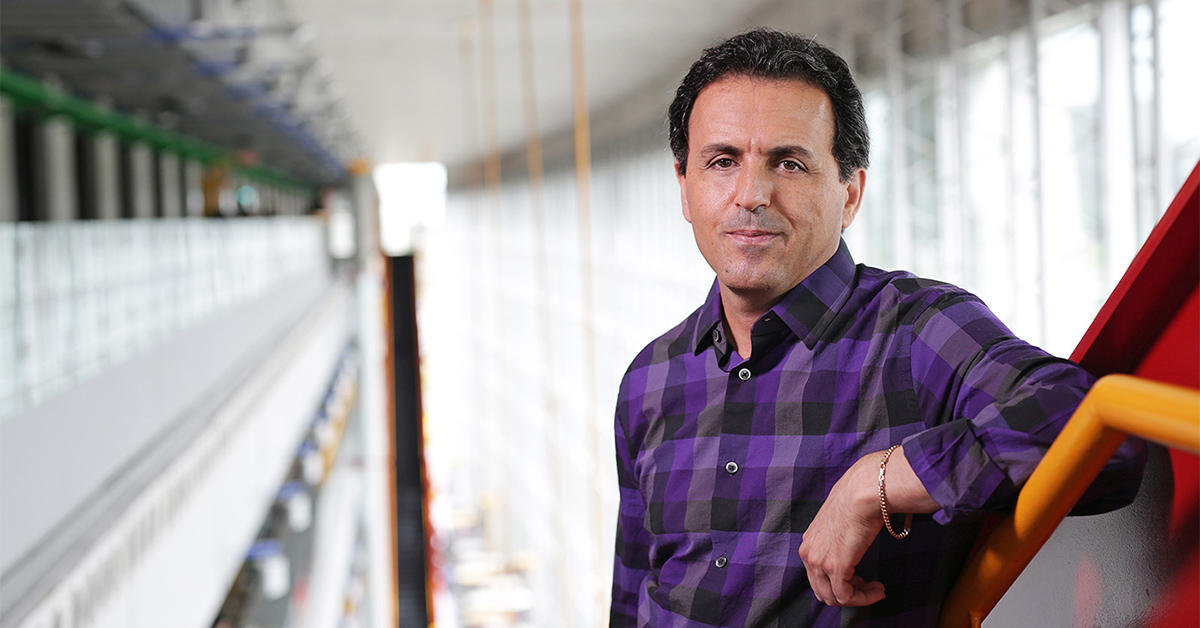Imagine if our personal protective gear could not only block the virus that causes COVID-19, but also kill it. Imagine if hospitals had walls, floors, and even bedsheets that could disinfect themselves. It’s not so far-fetched, says uOttawa Professor Ghassan Jabbour, whose most recent project used artificial intelligence to sift through data in order to find nanoparticles whose molecular functionalities could disarm the coronavirus.
“The virus itself has protein spikes covering the outside of it,” says Professor Jabbour. “That protein is the agent that latches onto human cells — a process called docking, in the same way you would dock your phone or tablet to charge it. We were looking for a nanoparticle that would cap the ends of the proteins, essentially deactivating the virus by weakening its ability to dock with the host. It’s like welding a key so it no longer fits in the lock.”
Professor Jabbour and Postdoctoral Researcher Ned Booker used AI, in the form of machine learning and data mining, to sift through hundreds of thousands of chemicals and test them to find out which of them were the greatest threat to the virus.
“We scanned through publisher databases, compiled all of the relevant articles about ‘COVID-19 and nanoparticles’, and pulled the names of chemicals related to that topic to see if any of them had the potential to disarm the virus,” he says. “We found about 50,000 chemicals. So, we digitized them, we gave them all chemical name codes — a bunch of ones and zeroes in different orders — then we started studying each one.”
By pairing each chemical with a silver- or copper-based nanoparticle, they could enhance its ability to dock onto, and directly incapacitate, the virus. “The better we do this docking, the better we can kill the virus. We said, ‘Okay, this chemical’s attachment is really strong. We gave them a grade, we ranked them, and we picked the champions that would be made to decorate the surface of the nanoparticles to enable them to better dock onto the virus.”
Most university research labs do not meet the biosafety standards needed to experiment on the SARS-Cov-2 virus itself. So instead, Jabbour’s group used uOttawa’s biosafety level 2 facilities to test the effectiveness of the nanoparticles against a surrogate virus.
Such experiments are very expensive and time consuming, but using artificial intelligence to zero in on a narrow set of champion chemicals drastically reduced both costs and time.
“Without the artificial intelligence, labs with the appropriate biosafety standards would have to run tests on thousands of chemicals, and these tests are very costly. For example, I paid more than $11,000 for three experiments. Imagine having to do a thousand experiments, how much it would cost… So, the AI approach should be rapidly adopted to circumvent this barrier.”
Jabbour and his research associate, Mutalifu Abulikemu, created the nanoparticles using simple, low-cost printing and spray-coating techniques. Such nanoparticles can be mixed in with other liquids, such as cleaning products, or coated on almost any surface or material, including plastics, paper, and cellulose. They can even be printed onto textiles, like cotton or polyester, to create antibacterial and antiviral clothing.
“We coated face masks with the nanoparticles, and we found it to be 99.998% effective against SARS-Cov-2. Another beautiful thing about this nanoparticle is that it can be regenerated by applying a tiny amount of electric current to it from a small battery, in the same way our bodies heal wounds through bioelectricity. You don’t need to dispose of it after a few uses.”
One of Jabbour’s priorities was to find an eco-friendly way to produce these nanoparticles; their roll-to-roll printing and spray-coating methods leave a low-carbon footprint.
“We don't use machinery that requires a lot of electricity or put out a lot of harmful products into the environment,” he says. “We call these green manufacturing approaches. So the impact is all positive.”
